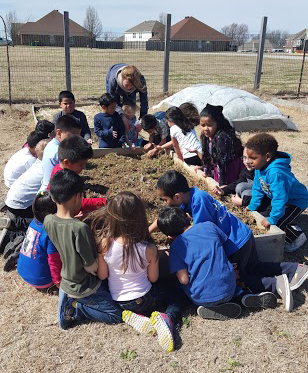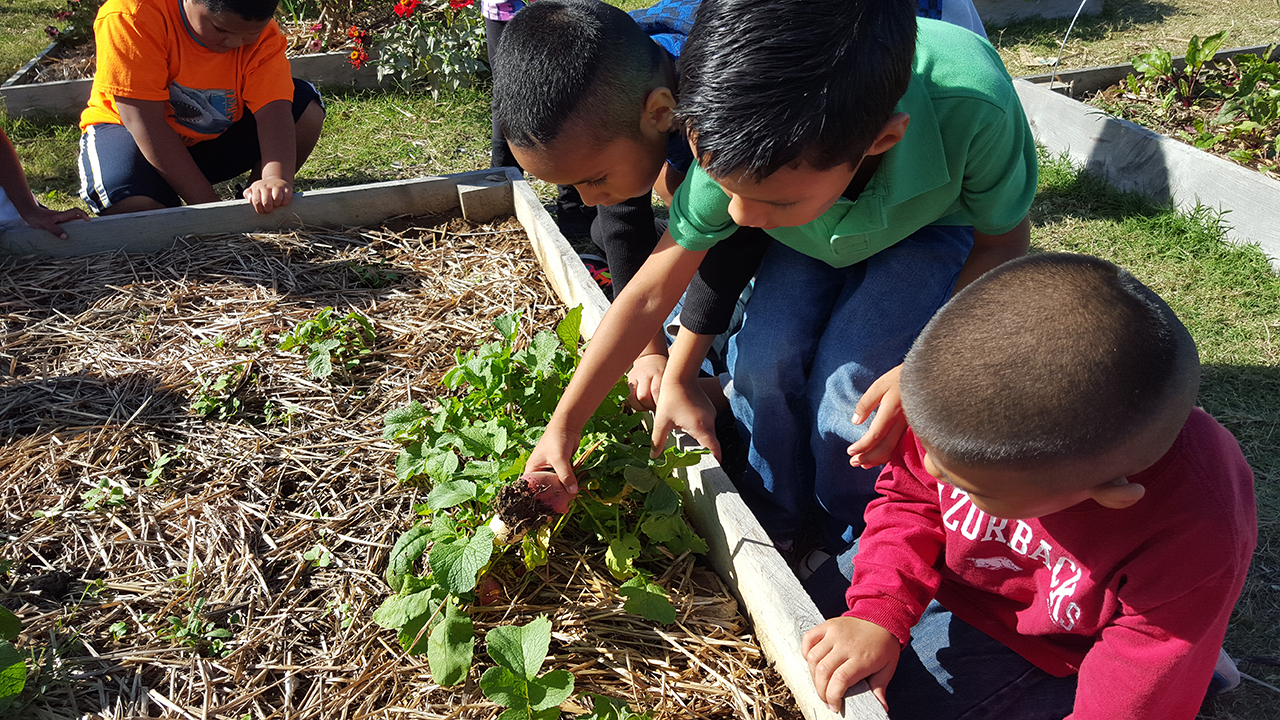Rachel Kraus is an AmeriCorps service member with FoodCorps, a nationwide team of leaders who connect kids to real food in school. You can find out more about it at www.foodcorps.org. Lifeway is a member of the FoodCorps Corporate Council and its support helps make Rachel’s position possible. You can read more about our partnership with FoodCorps here. Check out her first blog post here.
+++
The weeks leading into summer are a busy time for schools. Finding time to squeeze school garden planting into the mix of testing and year-end festivities can be challenging. As a FoodCorps service member at Bayyari Elementary School in Springdale, Arkansas, my role is helping teachers see how a garden is a worthwhile endeavor. When planted in a smart way, students and teachers can benefit both nutritionally and educationally.
The key is choosing vegetables that can be planted early and enjoyed before school gets out, like kale and sugar snap peas, or vegetables that are fast growing like radishes. Corn and tomatoes are ideal too. When planted at the end of the school year, they begin to fruit when the students return in August. That way, the students are guaranteed to see the fruits of their labor.
Planting Seeds and Growing a Garden
At Bayyari, we made a long list of what needed to be planted in our garden and when. The teachers then signed up for a garden bed based on what they liked and what fit their schedule. By the end of May, nearly all of the 29 beds in the school garden had been planted at least once, if not twice, with a crop that will go directly to the students. That’s right, students at Bayyari get to learn from the gardening experience AND eat all of the healthy, delicious harvest!
Here are some photos of the classes in action:

Our garden’s mouse!
Mrs. Ward’s class planted sugar snap peas and Swiss chard. Sadly, neither grew very well because of the mice that were living in our compost pile and underneath the shed. Everyone, including mice apparently, know that fresh vegetables are delicious AND good for you.

Potatoes from Mrs. Cleaver’s class.
Mrs. Cleaver’s kindergarten class planted potatoes that started as seedlings on the windowsill in their classroom. Before we planted them, the students cut the potatoes into chunks, being careful to leave at least two eyes per piece.

Radishes from Mrs. Porter’s and Mrs. Faldon’s classes.
Mrs. Porter’s and Mrs. Faldon’s classes planted radishes. They grew to be some of the largest radishes we’ve ever seen. We used them to make radish salsa!

Tilling soil to plant seeds.
Mrs. McDonald’s class planted sugar snap peas and carrots. They also planted okra, to be harvested later this summer, and pulled large weeds out of the garden paths.

Strawberries, onions, kale, and flowers thanks to Mr. O’Connell’s class.
Thanks to Mr. O’Connell, all of the fifth grade classes planted beds full of strawberries, onions, kale, and flowers to encourage pollinators.
Mrs. Chotard’s class planted green beans and helped tremendously with cleaning up the garden and potting some perennial flowers to adorn the posts of our outdoor classroom.

Those are some fresh carrots from Mrs. Tyree’s class!
Mrs. Tyree’s class planted carrots. The students harvested them and ate carrot after carrot in the shade of our outdoor classroom. One student, Yosselin, actually lost her tooth while munching on a freshly picked carrot!

Getting ready for some sugar snap peas from Mrs. Isaack’s class.
Mrs. Isaack’s class also planted sugar snap peas and helped everyone out by catching a couple mice.
Mrs. Sherman’s kindergarten class planted beets. They harvested them, practiced fine motor skills by cutting them up in the classroom, and then roasted the beets with apples and cinnamon. Yum!

Mrs. McEntire’s class pulling up radishes for fresh salsa!
Ms. McEntire’s class planted lettuce and radishes. We made radish salsa with some of the radishes, and the students were able to take the rest home so that they could make salad and salsa for their parents.
A school garden is a valuable way for students to learn how to grow and prepare nutritious foods. Learning about healthy foods at a young age encourages healthier eating habits throughout adolescence and eventually adulthood.